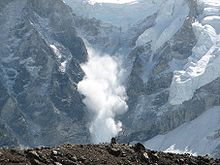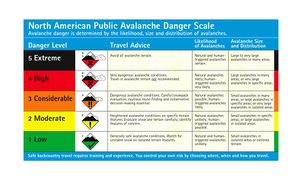انهيار جليدي

الانهيار الجليدي Avalanche هو تحرك مفاجيء لكمية من الجليد على جانب منحدر جبلي، وقد يحدث اضرارا بالغة إذا ماسقط من فج عالي. أكثر درجات الانحدار خطورة من حيث احتمال تسبيب البشر لانهيار جليدي هي ٢٨ درجة، وكقاعدة عامّة عندما يمكن التقاط الجليد من الأرض والإمساك به وفي نفس الحين يمكن التزلج على الجليد يكون احتمال الإنهيار عالي.
التصنيف
الجدول الاوروبي لخطر الانهيار الجليدي
In Europe, the avalanche risk is widely rated on the following scale, which was adopted in April 1993 to replace the earlier non-standard national schemes. Descriptions were last updated in May 2003 to enhance uniformity.[1]
In France, most avalanche deaths occur at risk levels 3 and 4. In Switzerland most occur at levels 2 and 3. It is thought that this may be due to national differences of interpretation when assessing the risks.[2]
[1] الاستقرار:
- Generally described in more detail in the avalanche bulletin (regarding the altitude, aspect, type of terrain etc.)
[2] additional load:
- heavy: two or more skiers or boarders without spacing between them, a single hiker or climber, a grooming machine, avalanche blasting
- light: a single skier or snowboarder smoothly linking turns and without falling, a group of skiers or snowboarders with a minimum 10 m gap between each person, a single person on snowshoes
Gradient:
- gentle slopes: with an incline below about 30°
- steep slopes: with an incline over 30°
- very steep slopes: with an incline over 35°
- extremely steep slopes: extreme in terms of the incline (over 40°), the terrain profile, proximity of the ridge, smoothness of underlying ground
الجدول الاوروبي لحجم الانهيار الجليدي
حجم الانهيار الجليدي:
| Size | Runout | Potential Damage | Physical Size |
|---|---|---|---|
| 1 - Sluff | Small snow slide that cannot bury a person, though there is a danger of falling. | Unlikely, but possible risk of injury or death to people. | length <50 m volume <100 m³ |
| 2 - صغير | Stops within the slope. | Could bury, injure or kill a person. | length <100 m volume <1,000 m³ |
| 3 - متوسط | Runs to the bottom of the slope. | Could bury and destroy a car, damage a truck, destroy small buildings or break trees. | length <1,000 m volume <10,000 m³ |
| 4 - كبير | Runs over flat areas (significantly less than 30°) of at least 50 m in length, may reach the valley bottom. | Could bury and destroy large trucks and trains, large buildings and forested areas. | length >1,000 m volume >10,000 m³ |
مقياس أمريكا الشمالية لخطر الانهيار الجليدي
In the الولايات المتحدة and Canada, the following avalanche danger scale is used. Descriptors vary depending on country.
التصنيف الكندي لحجم الانهيار الجليدي
The Canadian classification for avalanche size is based upon the consequences of the avalanche. Half sizes are commonly used.[3]
| Size | Destructive Potential |
|---|---|
| 1 | Relatively harmless to people. |
| 2 | Could bury, injure or kill a person. |
| 3 | Could bury and destroy a car, damage a truck, destroy a small building or break a few trees. |
| 4 | Could destroy a railway car, large truck, several buildings or a forest area up to 4 hectares. |
| 5 | Largest snow avalanche known. Could destroy a village or a forest of 40 hectares. |
تصنيف الولايات المتحدة لحجم الانهيار الجليدي
| Size | Destructive Potential[3] |
|---|---|
| 1 | Sluff or snow that slides less than 50m (150') of slope distance. |
| 2 | Small, relative to path. |
| 3 | Medium, relative to path. |
| 4 | Large, relative to path. |
| 5 | Major or maximum, relative to path. |
اختبار روتشبلوك
Slab avalanche hazard analysis can be done using the Rutschblock Test. A 2 m wide block of snow is isolated from the rest of the slope and progressively loaded. The result is a rating of slope stability on a seven step scale.[4]
انظر أيضاً
انسيابات متعلقة
كوارث انهيارات جليدية شهيرة
الهامش
- ^ [1][dead link]
- ^ An Analysis of French Avalanche Accidents for 2005-2006
- ^ أ ب Jamieson, Bruce (2000). Backcountry Avalanche Awareness. Canadian Avalanche Association. ISBN 0-9685856-1-2.
- ^ Doug Abromelt and Greg Johnson (winter, 2011-2012). "Learn how to: Perform A Rutschblock Test". USFS National Avalanche Center. Retrieved 2012-11-28.
{{cite web}}: Check date values in:|date=(help)
وصلات خارجية
- The Avalanche Education Project
- Surviving an Avalanche - A guide for children and youth
- Avalanche Awareness
- Avalanche Defense Photographs
- Canadian Avalanche Association
- CBC Digital Archives – Avalanche!
- Colorado Avalanche Information Center
- Center for Snow and Avalanche Studies
- Directory of European avalanche services
- Swiss Federal Institute for Snow and Avalanche Research
- sportscotland Avalanche Information Service
 Chisholm, Hugh, ed. (1911). . دائرة المعارف البريطانية (eleventh ed.). Cambridge University Press.
Chisholm, Hugh, ed. (1911). . دائرة المعارف البريطانية (eleventh ed.). Cambridge University Press. {{cite encyclopedia}}: Cite has empty unknown parameter:|coauthors=(help) But note the myths cited above- Evidence of heuristic traps in recreational avalanche accidents by Ian McCammon, National Outdoor Leadership School, Lander, WY, USA
- Utah Avalanche Center
- New Zealand Avalanche Centre
- Gulmarg Avalanche Center
- US Avalanche.org
- Sierra Avalanche Center (Tahoe National Forest)
